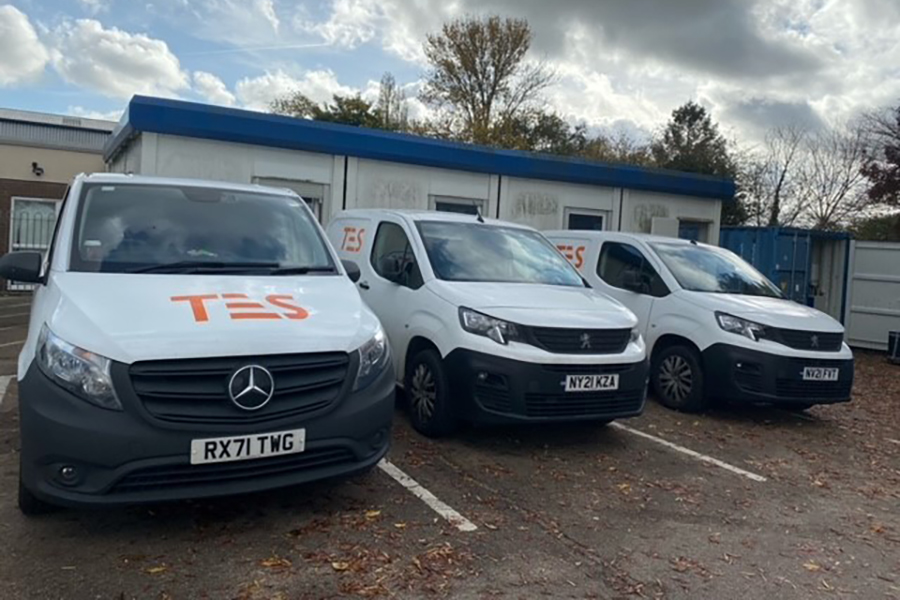“Managers will often say to me: “This individual must drive. We need him.” And I reply: “Well, if you need him, do the training with him, because some day you might not have him, and no one else will have him because he’ll have had a collision.” It’s not rocket science.”
Mick Kiely – Fleet Manager, TES2000

So how did you how did you get into fleet?
12 years ago, a friend of mine was killed in a non-fault RTC while he was driving home. I arrived at the scene to witness my colleague’s lifeless body in the driver’s seat.
I had started in the operations team. The company didn’t have a fleet manager at the time and that incident really opened my eyes. I decided to volunteer because the role needed filling. I did it part-time alongside my operational role to start with but eventually became the full-time fleet person and stepped away from operations.
I’m relentless in educating employees and directors about their responsibilities. I never want to have to knock on someone’s door and offer my condolences due to a road traffic collision.
Did you like it better than operations?
It’s not a case of liking it better than ops. It’s just that I knew I could make some changes and make a difference. Once I got my teeth into it, I never moved back.
What are the biggest challenges you faced as a fleet manager?
My biggest challenges are always drivers. Unfortunately, in the real world, we have a lot of people in their 50s and 60s who have old driving habits which die hard, so the big challenge is driver behaviour and getting them to change their attitudes.
What’s the key to doing that?
It took a lot of talking. In some cases, it took six months to get drivers to change their attitudes. I did have to show a lot of ‘nasty’ videos, as I call them, to bring the message home. And then I had to put my foot down, and say “Well, if you don’t abide by our policies, you won’t be driving a company vehicle”. It has worked.
Do drivers ever say that the old way was better?
Oh no, it is a lot better now. You see, our drivers didn’t see driving as their job. They have a vehicle to get to a site, do the job and go home. It’s different for someone who’s delivering parcels. Our people didn’t see their job as being a driver, even though it is part of their job, and that was that was a hard thing to drill into them.
Which of your achievements are you most proud of, Mick? I know you won Road Risk Manager of the Year 2022 at UK Fleet Champions Awards and TES also won the Company Driver Safety Award two years running.
[Smiles] It’s not the awards. It’s managing to reduce the collisions, reduce insurance premiums and change the drivers’ behavior. Yeah. I now get only two complaints a year!
What are your goals going forwards in terms of fleet?
Well, touch wood, I would like to have a year with no collisions. That’s what I would like to have.
We had five at fault collisions of some kind, including low speed manoeuvring last year, which is about 9% of the fleet, and 18 claims overall with our insurer. I had a dispute with our broker recently because the insurance company is including every incident, including attempted thefts which were unsuccessful. We currently report every incident, but this inclusion of attempted theft incidents pushing our ratio to nearer 20%. So going forwards, all drivers will report incidents to me and I will report the relevant incidents to the insurer, because insurance premiums should be based on the cost of claims for the previous year.
Looking at road safety generally, where should someone start if they want to improve their fleet?
Well, definitely driver training. I actually do practical training and e-learning. Before anyone gets a vehicle, they have to complete the driver profile, which is e-learning-based and they must complete two modules. One is speed awareness and one is rural road driving. I look at the scoring and I also look at the answers they give for the driver profile. And that tells you what you’re looking at.
I know there’s a cost involved in this. But I believe 100% in practical driver training. You have a guy who’s done his driving test in a car and he’s coming into work and you’re giving them a van. Yeah, it might be the same size, but it’s not the same piece of equipment. I got Safer Essex Road Partnership involved, and I got safety instructor Paul Ripley involved for carrying out the practical assessment, so it’s a third party’s view of this driver. That gives us an independent objective view of the driver, and the drivers respect that these are professionals and I will listen to them.
A lot of drivers who passed their test years ago feel better actually sitting down talking to someone because the online stuff baffles them. They are not technically minded. I have sat with some guys and done the e-learning with them and I just ask them the questions and I enter the answers. They felt more comfortable with that.
Is it important to take into account the different ways in which individuals learn?
Absolutely. I always speak to drivers about their telematics scores. I just have a quick word and show them the videos. Some companies have all the telematics and the dashcams but they never look at it. The technology doesn’t get results on its own. Monday is my day for going through the previous week’s telematics and speaking to drivers.
Do those conversations give you an opportunity to uncover whether there’s something else going on – problems or fatigue?
Probably 50% will tell you and 50% won’t as there can be a bit of embarrassment if it’s a personal situation. One of our biggest problems is harsh braking, as drivers approach roundabouts and traffic lights. They are under the speed limit but still going a bit too fast approaching the traffic lights. When you talk to them and you explain it, and they apologise and may not do it again for months. There’s often something else behind this but, as I said, only 50% will tell you why.
We had a collision back in August on the A12, where one of our drivers ran into the back of someone. I watched all the footage of this. I could see the van was moving to one side and moving back in. So I thought he’s either on the phone or he closed his eyes. I brought him in and said “Look, you’re not in trouble here, no one been injured, which is lucky. Can you tell me why this happened?”
He handed his phone over and the history showed he wasn’t on the phone at the time. Then he admits he had nodded off. So I looked at his shift pattern, and there was no operational reason for this fatigue. And then he admitted that he got no sleep before he went to work because he was minding the three children while his wife worked. So that opened something and I had to get HR involved. I understand people have these problems at home, especially when people have a lot of worries with bills. The problem is that him not getting home to his family because he died on the road won’t help them.
It’s a problem, particularly as 95% of our work is carried out at night. Unless these drivers are honest and say I’ve had no sleep today, so I can’t go to work tonight… but then they don’t get paid and then they have extra worries about bills.
How do you communicate the rules to your drivers?
We have a driver handbook which had a big refresh in October 2022. So far, the feedback has been very good. Since then, I’ve reworked it again. I’ve made reference to Driving for Better Business in the handbook and the Van Driver Toolkit because I think it’s something drivers can look at themselves.
I’ve also included some of the toolbox talks, drink driving, and fatigue, which is a big one for me.
How important is decarbonisation for you?
We’ve made all the cars electric but the problem we have with commercial vehicles is the range. The range at the moment does not suit the type of business we’re in, because we need around 250 miles for drivers to get to a site and back home.
Charging them is also an issue. Drivers keep their vans at home, so we would need to install charging posts for them, which is a £1500 cost. What happens if the driver then leaves, or moves house?
These guys also work at night in the middle of the countryside and, in a lot of cases, there’s no place to charge the vehicle. We have three charging points at head office in Colchester, but if I drive around Colchester town I’d be lucky to find one so, yeah, the problem is the infrastructure.
Electricity also varies greatly by cost depending on where you charge, doesn’t it?
The 150V fast chargers can be double the price of a 50 volt charger. I drive an electric car and I’m lucky that I live in London. There are 10 charging spots installed by the council within 400 metres of my house but that’s certainly not true for everyone. You know, I recently drove to Ireland in the electric car and, once I got past the Severn bridge in Wales, I was doomed looking for a charger because most of them weren’t working in the service stations.
Any final advice to other fleet managers?
I’m a great believer in fleet managers using what they have available to them. Your dashcam footage, your telematics, the Van Driver Toolkit. I don’t know why everyone in the country is not using the Van Driver Toolkit, that just amazes me. It’s made my job so much easier and I’ve even got friends in the industry to sign up to DfBB because they hadn’t heard of it. We’ve got stickers for the vans which are going out this week. TES 2000 supports Driving for Better Business. Check out the road safety partnership in your area – there are often great free resources which people aren’t using.
The Essex Safer Roads Partnership came in here and did a talk for our directors and managers about their responsibilities and I can honestly say that every one of them walked out of here and said “Whoa, I didn’t know that.” I’m sure thousands of directors around the country would be the same.






